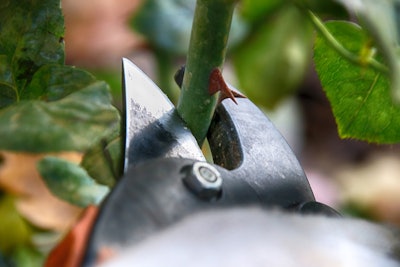
Light pruning and deadheading can be performed in both the summer and winter, but major pruning should be done in the early spring after the last frost in colder climates.
Before starting the pruning process, take a look at a few tips to keep in mind to make the job simple and quick.
Where to start
Begin the pruning process by removing the remaining leaves, as this will allow you to see everything on the bush clearly. This step can also help you remove any winter pests or diseases to ensure they don’t follow the plant into the new season.
When deciding on height, it simply comes down to pruning the bushes to be as tall as your customer wants them to be, but be sure to keep the height consistent.
The next step is to go ahead and remove any dead wood. If you find any dead wood, cut it back to the base to give the plant a chance to grow new, healthy canes. Take note of anything thinner than a pencil, as these should be removed as well.
Next, you’ll need to open up the center of the plant by taking out any crossing branches that rub together, as this can cause damage as well as encourage diseases. The overall goal is to create branches that reach upward with an open structure in a shape like a vase.
Prune the leftover canes by cutting ¼” to ½” above an outward-facing bud eye. New stems will grow in the direction of the bud, so the goal is to help coax them to grow outward instead of inward. To allow water to run off, make cuts at a 45-degree angle sloping away from the bud.
Once you’ve completed the cuts, be sure to protect the canes from rot and rose borers by sealing the cuts with some kind of sealer. After finishing the job, be sure to clean up the area surrounding the roses to keep any pests or diseases from coming back.
Different types of roses
If your customers have climbing roses, many of the same pruning principles will apply, but there are a few extra things to keep in mind with this specific type.
Since climbing roses have two types of canes, main and lateral, it’s important to know how to maintain both types. Main canes come directly from the base and should never be pruned. Climbing roses will put their energy into growing first and then will start flowering. This means that if that energy is spent trying to regrow main canes, it won’t flower.
The lateral canes will produce the flowers and when they are pruned, blooms will be more encouraged. Don’t worry about pruning to the outward-facing buds on climbing roses, as it’s unnecessary for this type of rose.
Pruning for Knock Out roses is similar to climbing roses with only a few exceptions.
Generally speaking, Knock Out roses are ready for their first pruning in their second or third season, after they’ve reached a mature height of about 3-4 feet. Buds will begin to form in either late winter or early spring, and they will begin blooming on new growth, which means old, dead or broken canes should be cut back to the base.
If your customers have rose hips, just go ahead and leave them throughout the fall and winter, as they alert the roses it’s time for dormancy. In climates that are colder, roses are naturally triggered to go dormant, but in the warmer climates, they need a little help from the rose hips to navigate the weather.











